Working on a simple c GUI library, I'm starting with the winapi backend and having some problems right now calculating the preferred sizes of controls. I'm comparing my results with those of Windows.Forms.
Right now, I'm using values from Design Specifications and Guidelines - Visual Design Layout (like Buttons and TextBoxes being 14 "Dialog Logical Units" high) for calculating the pixel sizes in the winapi implementation, while keeping everything default with Windows Forms. I created these simple demo implementations:
Windows Forms (demo.cs):
using System.Drawing;
using System.Windows.Forms;
namespace W32CtlTest
{
public class Demo : Form
{
private FlowLayoutPanel panel;
private Button button;
private TextBox textBox;
public Demo() : base()
{
Text = "winforms";
panel = new FlowLayoutPanel();
button = new Button();
button.Text = "test";
button.Click += (sender, args) =>
{
Close();
};
panel.Controls.Add(button);
textBox = new TextBox();
panel.Controls.Add(textBox);
Controls.Add(panel);
}
protected override Size DefaultSize
{
get
{
return new Size(240,100);
}
}
public static void Main(string[] argv)
{
if (argv.Length < 1 || argv[0] != "-s")
{
Application.EnableVisualStyles();
}
Application.Run(new Demo());
}
}
}
compile with C:\Windows\Microsoft.NET\Framework\v4.0.30319\csc.exe /out:demo.exe /lib:C:\Windows\Microsoft.NET\Framework\v4.0.30319 /reference:System.Windows.Forms.dll,System.Drawing.dll demo.cs
Win32 API (demo.c):
#include <string.h>
#include <windows.h>
#include <commctrl.h>
static HINSTANCE instance;
static HWND mainWindow;
static HWND button;
static HWND textBox;
#define WC_mainWindow L"W32CtlTestDemo"
#define CID_button 0x101
static NONCLIENTMETRICSW ncm;
static HFONT messageFont;
static TEXTMETRICW messageFontMetrics;
static int buttonWidth;
static int buttonHeight;
static int textBoxWidth;
static int textBoxHeight;
/* hack to enable visual styles without relying on manifest
* found at http://stackoverflow.com/a/10444161
* modified for unicode-only code */
static int enableVisualStyles(void)
{
wchar_t dir[MAX_PATH];
ULONG_PTR ulpActivationCookie = 0;
ACTCTXW actCtx =
{
sizeof(actCtx),
ACTCTX_FLAG_RESOURCE_NAME_VALID
| ACTCTX_FLAG_SET_PROCESS_DEFAULT
| ACTCTX_FLAG_ASSEMBLY_DIRECTORY_VALID,
L"shell32.dll", 0, 0, dir, (LPWSTR)124,
0, 0
};
UINT cch = GetSystemDirectoryW(dir, sizeof(dir) / sizeof(*dir));
if (cch >= sizeof(dir) / sizeof(*dir)) { return 0; }
dir[cch] = L'\0';
ActivateActCtx(CreateActCtxW(&actCtx), &ulpActivationCookie);
return (int) ulpActivationCookie;
}
static void init(void)
{
INITCOMMONCONTROLSEX icx;
icx.dwSize = sizeof(INITCOMMONCONTROLSEX);
icx.dwICC = ICC_WIN95_CLASSES;
InitCommonControlsEx(&icx);
ncm.cbSize = sizeof(ncm);
SystemParametersInfoW(SPI_GETNONCLIENTMETRICS, ncm.cbSize, &ncm, 0);
messageFont = CreateFontIndirectW(&ncm.lfStatusFont);
HDC dc = GetDC(0);
SelectObject(dc, (HGDIOBJ) messageFont);
GetTextMetricsW(dc, &messageFontMetrics);
SIZE sampleSize;
GetTextExtentExPointW(dc,
L"ABCDEFGHIJKLMNOPQRSTUVWXYZabcdefghijklmnopqrstuvwxyz",
52, 0, 0, 0, &sampleSize);
ReleaseDC(0, dc);
buttonWidth = MulDiv(sampleSize.cx, 50, 4 * 52);
buttonHeight = MulDiv(messageFontMetrics.tmHeight, 14, 8);
textBoxWidth = 100;
textBoxHeight = MulDiv(messageFontMetrics.tmHeight, 14, 8);
instance = GetModuleHandleW(0);
}
static LRESULT CALLBACK wproc(HWND w, UINT msg, WPARAM wp, LPARAM lp)
{
switch (msg)
{
case WM_CREATE:
button = CreateWindowExW(0, L"Button", L"test",
WS_CHILD|WS_VISIBLE|BS_PUSHBUTTON,
2, 2, buttonWidth, buttonHeight,
w, (HMENU)CID_button, instance, 0);
SendMessageW(button, WM_SETFONT, (WPARAM)messageFont, 0);
textBox = CreateWindowExW(WS_EX_CLIENTEDGE, L"Edit", L"",
WS_CHILD|WS_VISIBLE|ES_AUTOHSCROLL,
6 + buttonWidth, 2, textBoxWidth, textBoxHeight,
w, 0, instance, 0);
SendMessageW(textBox, WM_SETFONT, (WPARAM)messageFont, 0);
break;
case WM_DESTROY:
PostQuitMessage(0);
break;
case WM_COMMAND:
switch (LOWORD(wp))
{
case CID_button:
DestroyWindow(w);
break;
}
break;
}
return DefWindowProcW(w, msg, wp, lp);
}
int main(int argc, char **argv)
{
if (argc < 2 || strcmp(argv[1], "-s"))
{
enableVisualStyles();
}
init();
WNDCLASSEXW wc;
memset(&wc, 0, sizeof(wc));
wc.cbSize = sizeof(wc);
wc.hInstance = instance;
wc.lpszClassName = WC_mainWindow;
wc.lpfnWndProc = wproc;
wc.hbrBackground = (HBRUSH) COLOR_WINDOW;
wc.hCursor = LoadCursorA(0, IDC_ARROW);
RegisterClassExW(&wc);
mainWindow = CreateWindowExW(0, WC_mainWindow, L"winapi",
WS_OVERLAPPEDWINDOW, CW_USEDEFAULT, CW_USEDEFAULT, 240, 100,
0, 0, instance, 0);
ShowWindow(mainWindow, SW_SHOWNORMAL);
MSG msg;
while (GetMessageW(&msg, 0, 0, 0) > 0)
{
TranslateMessage(&msg);
DispatchMessageW(&msg);
}
return (int)msg.wParam;
}
compile with gcc -odemo.exe -O2 demo.c -lgdi32 -lcomctl32
The test code is also available on github
It looks like this on windows 10, with visual styles enabled in the upper row and disabled in the lower row:
One thing I soon found out is that Windows.Forms doesn't use the message font (as I had expected) but instead uses the DEFAULT_GUI_FONT Although that's not the right thing to do, I changed my win32 code accordingly so I can compare the results better:
For completeness, here is what it looks like on windows 7 without visual styles:
Now my questions are:
Is it correct to use the message font? So, Windows.Forms definitely got this one "wrong"?
Obviously Windows.Forms uses the 14 DLU height for Buttons, but some smaller height for TextBoxes. This contradicts the Design Specifications. So is Windows.Forms wrong here as well? Or should TextBoxes in fact be smaller, so the text doesn't look like it's "hanging from the ceiling"? I think this does look better the way Windows.Forms does it.
Comparing visual styles enabled/disabled, I find that without visual styles, I get the same height for my button and my text box, but with visual styles enabled on windows 10, the text box is actually higher. Is there something like "theme specific metrics" and if so, how can I use that to correct my calculations?



